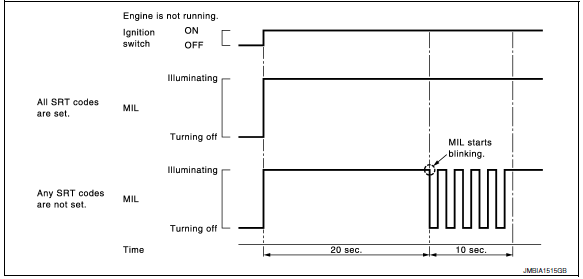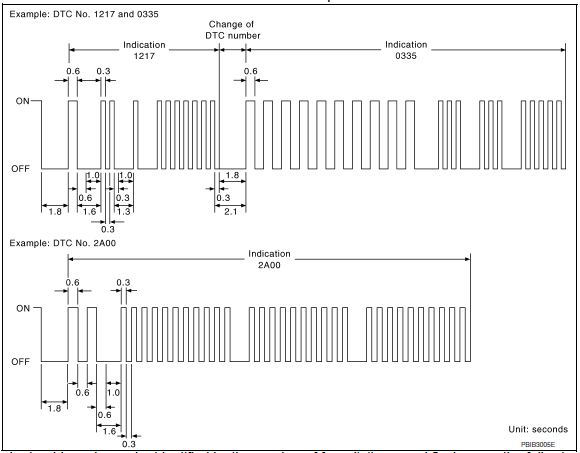Nissan Sentra Service Manual: On board diagnosis function
ON BOARD DIAGNOSIS ITEM
The on board diagnostic system has the following functions.
| Diagnostic test mode | Function |
| Bulb check | MIL can be checked. |
| SRT status | ECM can read if SRT codes are set. |
| Malfunction warning | If ECM detects a malfunction, it illuminates or blinks MIL to inform the driver that a malfunction has been detected. |
| Self-diagnostic results | DTCs or 1st trip DTCs stored in ECM can be read. |
| Accelerator pedal released position learning | ECM can learn the accelerator pedal released position. Refer to EC-138, "Work Procedure". |
| Throttle valve closed position learning | ECM can learn the throttle valve closed position. Refer to EC-139, "Work Procedure". |
| Idle air volume learning | ECM can learn the idle air volume. Refer to EC-140, "Work Procedure". |
| Mixture ratio self-learning value clear | Mixture ratio self-learning value can be erased. Refer to EC-142, "Work Procedure". |
BULB CHECK MODE
Description
This function allows damage inspection in the MIL bulb (blown, open circuit, etc.).
Operation Procedure
- Turn ignition switch ON
- The MIL on the instrument panel should stay ON.
If it remains OFF, check MIL circuit. Refer to EC-467, "Diagnosis Procedure".
SRT STATUS MODE
Description
This function allows to read if ECM has completed the self-diagnoses of major emission control systems and components. For SRT, refer to EC-61, "DIAGNOSIS DESCRIPTION : System Readiness Test (SRT) Code".
Operation Procedure
- Turn ignition switch ON and wait 20 seconds.
- SRT status is indicated as shown blow.
- ECM continues to illuminate MIL if all SRT codes are set.
- ECM blinks MIL for about 10 seconds if all SRT codes are not set.

MALFUNCTION WARNING MODE
Description
In this function ECM turns on or blinks MIL when it detects a malfunction in the emission control system components and/or the powertrain control components (which affect vehicle emissions) to inform the driver that a malfunction has been detected.
Operation Procedure
- Turn ignition switch ON.
- Check that MIL illuminates.
If it remains OFF, check MIL circuit. Refer to EC-61, "DIAGNOSIS DESCRIPTION : System Readiness Test (SRT) Code".
- Start engine and let it idle
- For two trip detection logic diagnoses, ECM turns on MIL when it detects the same malfunction twice in the two consecutive driving cycles.
- For 1st trip detection logic diagnoses, ECM turns on MIL when it detects a malfunction in one driving cycle.
- ECM blinks MIL when it detects a malfunction that may damage the three way catalyst (misfire).
SELF-DIAGNOSTIC RESULTS MODE
Description
This function allows to indicate DTCs or 1st trip DTCs stored in ECM according to the number of times MIL is blinking.
How to Set Self-diagnostic Results Mode
NOTE:
- It is better to count the time accurately with a clock.
- It is impossible to switch the diagnostic mode when an accelerator pedal position sensor circuit has a malfunction.
- After ignition switch is turned off, ECM is always released from the “self-diagnostic results” mode.
- Confirm that accelerator pedal is fully released, turn ignition switch ON and wait 3 seconds.
- Repeat the following procedure quickly five times within 5 seconds.
- Fully depress the accelerator pedal.
- Fully release the accelerator pedal.
- Wait 7 seconds, fully depress the accelerator pedal and keep it depressed for approx. 10 seconds until the MIL starts blinking.
NOTE:
Do not release the accelerator pedal for 10 seconds if MIL starts blinking during this period. This blinking is displaying SRT status and is continued for another 10 seconds.
- Fully release the accelerator pedal.
ECM has entered to “Self-diagnostic results” mode.
NOTE:
Wait until the same DTC (or 1st trip DTC) appears to completely confirm all DTCs.

How to Read Self-diagnostic Results
The DTC and 1st trip DTC are indicated by the number of blinks of the MIL as shown below.
The DTC and 1st trip DTC are displayed at the same time. If the MIL does not illuminate in diagnostic test mode I (Malfunction warning), all displayed items are 1st trip DTCs. If only one code is displayed when the MIL illuminates in “malfunction warning” mode, it is a DTC; if two or more codes are displayed, they may be either DTCs or 1st trip DTCs. DTC No. is same as that of 1st trip DTC. These unidentified codes can be identified by using the CONSULT or GST. A DTC will be used as an example for how to read a code.

A particular trouble code can be identified by the number of four-digit numeral flashes per the following.

The length of time the 1,000th-digit numeral flashes on and off is 1.2 seconds consisting of an ON (0.6-seconds) - OFF (0.6-seconds) cycle.
The 100th-digit numeral and lower digit numerals consist of a 0.3-seconds ON and 0.3-seconds OFF cycle.
A change from one digit numeral to another occurs at an interval of 1.0-second OFF. In other words, the later numeral appears on the display 1.3 seconds after the former numeral has disappeared.
A change from one trouble code to another occurs at an interval of 1.8-seconds OFF.
In this way, all the detected malfunctions are classified by their DTC numbers. The DTC 0000 refers to no malfunction.
Refer to EC-94, "DTC Index".
How to Erase Self-diagnostic Results
By performing this procedure, ECM memory is erased and the following diagnostic information is erased as well.
- Diagnostic trouble codes
- 1st trip diagnostic trouble codes
- Freeze frame data
- 1st trip freeze frame data
- System readiness test (SRT) codes
- Test values
NOTE:
Also, if a battery terminal is disconnected, ECM memory is erased and the diagnostic information as listed above is erased. (The amount of time required for erasing may vary from a few seconds to several hours.)
- Turn ignition switch OFF and wait at least 10 seconds.
- Turn ignition switch ON.
- Turn ignition switch OFF and wait at least 10 seconds.
- Turn ignition switch ON.
- Set ECM in “self-diagnostic results” mode.
- The diagnostic information has been erased from the backup memory in the
ECM.
Fully depress the accelerator pedal and keep it depressed for more than 10 seconds.
- Fully release the accelerator pedal, and confirm the DTC 0000 is displayed.
 Diagnosis description : malfunction indicator lamp (MIL)
Diagnosis description : malfunction indicator lamp (MIL)
When emission-related ECU detects a malfunction in the emission
control systems components and/or the powertrain control components
(which affect vehicle emissions), it turns on/blinks MIL to
infor ...
 Consult function
Consult function
FUNCTION
Diagnostic test mode
Function
Self Diagnostic Results
Self-diagnostic results such as 1st trip DTC, DTCs and 1st trip
freeze frame data or freeze frame data
can ...
Other materials:
Precaution for Supplemental Restraint System (SRS) "AIR BAG" and "SEAT BELT
PRE-TENSIONER"
The Supplemental Restraint System such as “AIR BAG” and “SEAT BELT
PRE-TENSIONER”, used along
with a front seat belt, helps to reduce the risk or severity of injury to the
driver and front passenger for certain
types of collision. Information necessary to service the system ...
Ipdm-e branch line circuit
Diagnosis procedure
1.Check connector
Turn the ignition switch off.
Disconnect the battery cable from the negative terminal.
Check the terminals and connectors of the ipdm e/r for damage, bend and
loose connection (unit side
and connector side).
Is the inspection result normal?
Yes ...
Basic inspection
Diagnosis and repair workflow
Work Flow
OVERALL SEQUENCE
DETAILED FLOW
1.OBTAIN INFORMATION ABOUT SYMPTOM
Interview the customer to obtain as much information as possible about the
conditions and environment under
which the malfunction occurred.
>> GO TO 2.
2.CHECK SYMPTOM
...
